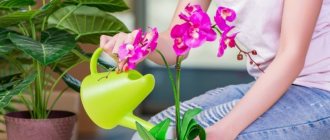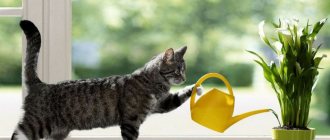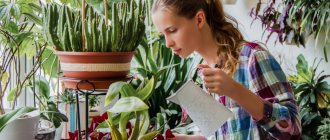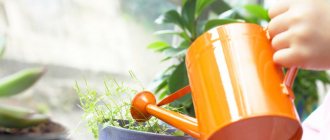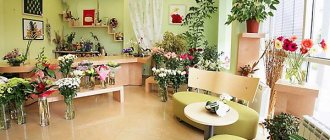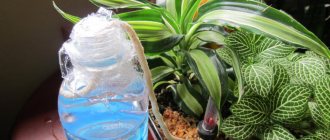The main problem of watering your house plants is to solve the following questions: how often should you water indoor flowers?, what kind of water should you water indoor flowers?, is it possible to water indoor flowers with beer?, what should you water indoor flowers with for rapid growth and abundant flowering?, can should indoor plants stay without watering for a while?, how to water indoor flowers correctly and is it possible to water indoor flowers with potassium permanganate?, what kind of water should there be for watering indoor plants?, is it possible to water indoor flowers with boiled water?, we will try to answer all these questions below. You need to water the flowers in such a way that your indoor plant receives a sufficient amount of water.
Moisture is involved in processes such as nutrition of roots, leaves and the entire plant as a whole. And most importantly, it takes an active part in photosynthesis. Through irrigation water, basic nutrients enter the soil by adding various mineral fertilizers to it.
If granular mineral fertilizers of prolonged action are used, interaction with liquid gradually contributes to their erosion and penetration into the soil. Liquid fertilizers added to water for irrigation mainly feed the roots, through which all the nutrients flow further to the plant. It is important to know how to properly water indoor plants.
Watering each plant is directly dependent on the place where it grows; in other words, it is necessary to ensure that watering occurs naturally in the homeland of each plant. When watering, you should also take into account the time of year, winter, spring or summer, autumn.
Each period of time requires its own watering regime. Consider lighting and temperatures at all times of the year. Of course, you need to understand the size and age of the flower, and how much moisture it needs. Of course, the peculiarity of the soil is its water permeability and ability to retain moisture.
Herbaceous plants, such as calathea, begonia, ferns, need more moisture, watering should be plentiful. Plants with succulent foliage and fleshy stems contain moisture reserves there, which means they are not so demanding when it comes to watering.
In winter, the need for watering is noticeably less.
Rare watering
Usually these are plants that grow in desert or semi-desert. The soil should dry out completely between waterings for such plants. This applies to all cacti, Crassula, Gavrotia, Sansevieria, as well as all bulbous and corm plants (gloxinia).
Determining the need for watering is quite simple. To do this, just look at the soil. Dry soil becomes lighter in color as it dries. It can be checked by touch. Or use special devices to measure soil moisture. There is also a method for determining the humidity in a pot with a plant. This is the weight of the pot and the sound the pot makes when you tap it.
In large pots or tubs, we determine the humidity not on the surface, but at a depth of 15 centimeters. This can be determined using measuring instruments or a stick. If there is still soil on the stick, then it is too early to water. Wait until the soil dries out a little more. In spring and summer, watering needs to be increased. And moisture-loving plants are watered twice a day (morning/evening).
How often to water indoor flowers in the fall
There is a fairly well-known rule that from May to September, house flowers are watered much more abundantly than during the rest of the year. This means that in the fall, watering and spraying of plants is gradually reduced, focusing on the temperature and humidity of the air, as well as the condition of the soil.
There are some other ways to determine soil moisture. For example, you can take a small handful of earth and knead it in your hands. If it breaks up into small particles, then the soil is dry and it’s time to water the plant. Another way is to tap the bottom of the pot. If the soil is dry, the sound will be louder than when tapping on a pot with wet soil. You can also check the soil using a moisture indicator, which, however, if there is a large amount of mineral salts in the soil, can be wrong.
Indoor flowers kept in ceramic dishes require much more moisture than others.
- What to do with indoor plants in the fall
A few important points to keep in mind.
If in the spring plants need nitrogen fertilizers for growth, then in the second half of summer and early autumn they need phosphorus-potassium fertilizers - to strengthen the root system, resistance to temperature changes and various diseases. Therefore, combine watering with fertilizing, following the instructions for a particular fertilizer.
Proper watering
We bring the edge of the spout of the watering can to the edge of the soil, so that when watering the soil does not wash away and so that water does not get on the leaves. Some of the water must come out through the drainage into the pan. After some time, the water should be removed from the pan. If the soil is very dry, water it with small portions of water until air bubbles stop forming on the surface. The soil may be very dry, and in this case a distance will form between the plant and the walls of the pot.
When watering, the water will immediately flow down the walls into the pan, this will prevent it from saturating all the soil in the pot. In order for such soil to become saturated with moisture, the pot must be placed in water for some time, the necessary moisture will be absorbed by the soil, and the excess will remain untouched.
If water does not come out through the drainage hole, you need to check whether it is clogged with soil particles, or perhaps the plant has grown and its roots have blocked the outlet for moisture. This absolutely cannot be allowed. Under such circumstances, moisture stagnation begins, and this will soon lead to rotting of the roots. Water stagnation will occur if you have heavy soil. Which contains clay, or the soil is too compacted and has become poorly permeable to moisture. Many people pour water into a tray, expecting that it will nourish the plant in the pot. This is a big mistake. It is believed that if you water plants in a tray, you can avoid yellowing of the leaves and the formation of spots on them. This is a misconception - spots on the leaves appear if the water for irrigation is lower than the air temperature. The optimal water temperature for irrigation should be equal to the air temperature in the room. But in winter, it is allowed for the water to be a couple of degrees warmer than the air in the room.
If your plant is quarantined or weakened by disease. Such plants need less watering.
In large flower pots or tubs. Or for large areas of landscaping, green areas or clearings must be provided with good drainage. If the pot does not include a tray, there should be a larger layer of drainage at the bottom. Excess moisture will accumulate there, which will prevent roots from being in the water. Expanded clay and moisture-absorbing materials (perlite) are usually used.
How often to water indoor flowers in spring
Spring is traditionally considered the right time to replant houseplants. And since this is also the time of the beginning of the growing season, growing and developing flowers simply need a sufficient volume of liquid.
It is difficult to name the specific time interval that needs to be maintained between waterings. In spring, during the period of growth and development, the optimal frequency of watering ranges from 3-7 days, depending on the air temperature outside the window and in the room with flowers, the presence of heating, the degree of air humidity and its circulation.
The main sign that your plants are not getting enough water is dry soil that can be easily pierced with a wooden stick. If the stick easily went several centimeters deep and after removing it you found that it was dry, you can safely water the plant. But this check must be performed very carefully so as not to damage the root of the plant.
Once or twice a month, watering the plants is combined with root feeding. Manufacturers of mineral fertilizers recommend dissolving them in water and applying them at the root once every two weeks in the warm season. In this case, fertilizing should alternate with treatment against diseases and pests, which is also carried out once every two weeks, and it can be both root and foliar. For better growth in the spring, all plants, including domestic ones, require fertilizing with nitrogen fertilizers, and from folk remedies - thick infusions of eggshells or onion peels.
And a little about spraying. This is also a kind of watering, however, some flowers (especially during the flowering period) suffer from liquid getting on the leaves (plants of the Solanaceae family, in particular petunia), and especially from stagnation of water in their axils. In this case, you need to spray not the plants themselves, but the air within a radius of several meters from them.
- Why indoor plants don't bloom and how to fix it
What is the reason that your home flowers have ceased to please you with buds?
The frequency of spraying indoor plants with water without adding other means is also directly dependent on the air humidity in the room. If the heating has not yet been turned off, and it is already warm outside, then you need to spray indoor plants at least twice a week and water the same number of times. This is especially important if your flowers are on a windowsill under which there is a heating device. If the situation is diametrically opposite, then watering and spraying of plants should be increased very carefully, focusing on the condition of the soil (dry or wet) and leaves (if they begin to droop, it’s definitely time to water the plant).
As soon as the average daily air temperature outside the window rises to 10-15°C, some flowers can be safely placed on the balcony (provided that it is glazed). These include, in particular, Ficus Benjamin, Aspidistra, Boxwood, Crassula, Aloe, Kalanchoe, Begonia, Primrose, Hydrangea, Hibiscus, Monstera and Azalea.
- What flowers to plant on the balcony - a list of names with photo ideas
How to place flowers on the balcony: design, suitable types, care tips.
Plants that are afraid of cold air and drafts (orchid, spathiphyllum, anthurium) are better left in the room even in the summer, but they will have to be additionally sprayed. For temporary balcony pets, before the sun begins to shine brightly, it is enough to water and spray them once a week.
Water for irrigation
For all plants - optimal watering with soft water. When using tap water, try to let it sit for at least three days. Since tap water has a high probability of an alkaline reaction. With such a reaction with the soil, it becomes alkalized - white stripes of the oxidative process of the soil appear on the surface and edges of the pot. This is the first sign that your water is alkaline. In this case, the water for irrigation must be acidified. This is done by adding distilled water, or adding a weak solution of citric acid. Thus bringing the soil acidity to the required parameters to 5-5.5 pH. You can check the acidity of the soil with a special device.
What is better - top or bottom watering?
Top watering of indoor plants is a more familiar method for many, when water flows to the roots from top to bottom. At the same time, the upper part of the soil remains moist longer. It is impossible to say unequivocally which method is better and more effective; the individual needs of the plants must be taken into account. So, for bulbous plants that do not like to stay in a damp environment for a long time, it is better to use top watering to reduce the risk of rotting of the bulbs.
There are plants for which it is inconvenient to use top watering. For example, these are some types of large cacti, also nolina and adenium, for which it is not advisable to moisten the caudex. Bottom watering is convenient if the plant “does not like” getting its leaves wet; such picky plants include violet, cyclamen, and gloxinia. In addition, it is more advisable to carry out bottom watering if the earthen ball is very dry; in this case, when watered from above, the soil simply will not absorb the moisture that will flow along the walls of the pot.
Most deciduous plants do not care how moisture is supplied to them. It's more about convenience! Thus, it is more logical to “water” large specimens from above, and plants with a lush crown – through a tray. It is believed that in the process of irrigation by immersion, moisture reaches the roots more quickly and is better absorbed into the soil. But top watering is no less effective if it is abundant!
✿
We water the plants during the holidays.
We can all go on vacation, a business trip and be absent for some time. It's good if you have someone to water your plants. If you leave, you have to ask friends or neighbors, relatives and friends, to look after your plants. But you can come up with automatic watering. Or think in advance about planting plants in pots that are equipped with automatic watering. In such pots, plants can go without watering for almost a month. Self-watering pots are an expensive proposition.
Let's look at more budget-friendly methods:
- — the most common way to auto-water plants is to use a cord. You need to place a container of water above the level of the pots with plants. We place the laces in this container (as many as you need to water the pots) and the other end of each lace from the container with water into the pot with the plant. It is better to use wool or cotton lace. The water will gradually be absorbed by the string and transferred to the plant pot.
- - if your pots are clay, dig them into a container with peat (right along with the pots). The peat container should be large enough to accommodate all of your pots. The peat must be moistened very well and the plants themselves must be watered abundantly. Instead of peat, I recommend using expanded clay. It can always be dried and removed, but peat may smell damp in the room. The disadvantage of this method is that it is possible to damage ceramic pots, especially if they are designer or decorative.
- - you can place all the plants together next to each other. In this case, the evaporation of moisture will be less. The more crowded they are on the pallet, the slower the moisture will evaporate. It is advisable to remove the tray with plants from the window. It's better to have a lack of light. With plenty of light, water consumption is greater.
- - There is also a method of watering, for this you will need all kinds of containers. We pour water into them and place a pot with a plant on top. You need to insert a cord into the drainage hole, and lower its other end into the water of the second container. Thus, each pot with a plant will be provided with its own watering. Plants in large pots can be safely left for three weeks without watering, but water them well before leaving.
- — the use of film can reduce moisture evaporation. It is covered on top of the pot. But I would not recommend doing this, there will be a greenhouse effect and the plant trunk may begin to rot. This leads to waterlogging of the soil and rotting of the root system.
- - place the plant in a confined space - for example, an aquarium. But this method is not available to everyone. The bottom is covered with expanded clay, peat or sphagnum, pour water and place the plants. The peculiarity of this method is not entirely convenient, since the pots must stand on their own pallets and there should be no water in them. The plants are well watered and the aquarium itself is covered with glass or film. In this mode, the plants can stand for a month. In such a closed system, water evaporates less and the moisture lasts for a long time.
Water is the source of life for plants. Each plant has its own watering regime and its own watering requirements. Learn how to water your plants and they will thank you. And you will understand how often to water indoor plants. Good luck to you.
How often to water indoor flowers in winter
Some flower growers claim that in winter plants can hardly be watered or fed. This is fundamentally wrong, since even in the cold season, your pets can get sick, be attacked by pests, or even die from lack of moisture. There are those who prefer to bloom in winter (phalaenopsis, spathiphyllum, hippeastrum, Schlumbergera), which means that the period of active growing season falls precisely at this time, or does not stop at all. For this reason, caring for such a plant should correspond exclusively to the period of its growth or rest.
All other plants should be watered inactively as the soil dries. It is not recommended to use self-watering systems, or to moisten plants through trays, as in the warm season: this winter can contribute to the appearance of mold on the soil and the occurrence of diseases in the plant. Fertilizing plants, as well as treating them against pests, is carried out no more than once every month and a half.
- Helping indoor plants survive the winter - 5 important points you might have forgotten
Some indoor plants fall asleep in winter, while others, on the contrary, are preparing to bloom. And everyone needs special care!
Do you have mandatory rules regarding watering indoor flowers throughout the year, and what tricks do you know on this topic?
